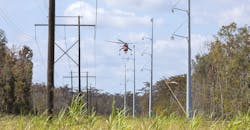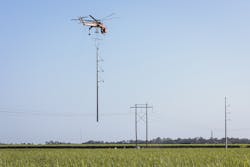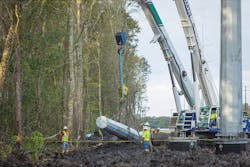Transmission Challenges in a Louisiana Bayou
The bayous of southern Louisiana are among the most ecologically diverse and fragile in North America. They are home to a broad and unique array of wildlife, pristine wetlands, cypress forests and plant species. Without question, a transmission construction project through this kind of terrain would need to be planned and managed with the utmost care and sensitivity.
When Entergy Louisiana named Burns & McDonnell the program manager and engineering, procurement and construction (EPC) contractor for the Terrebonne-to-Bayou Vista 230-kV transmission line project, the first item on the agenda was to create a detailed environmental assessment. This assessment formed the foundation for a plan to minimize disturbance of the tightly interwoven ecosystems in Louisiana’s bayou country. Covering more than 10,000 sq miles (25,900 sq km) and extending 30 miles (48 km) inland, the coastal wetland zone of Louisiana accounts for approximately 40% of all the wetlands in the lower 48 states.
The Project
The Terrebonne-to-Bayou Vista line is a collaborative effort between Entergy Louisiana and Cleco Power, formerly Central Louisiana Electric Co. The total new line spans 36 miles (58 km), with the Entergy project starting from the existing Terrebonne substation on the eastern point and spanning 24 miles (39 km) through the heart of Louisiana’s bayou system to a point at Bayou Boeuf near Amelia, Louisiana, where it dead-ends at the Cleco utility structures. Cleco’s project includes building the remaining 12 miles (19 km) of new 230-kV transmission line and related interconnection work, eventually connecting to the utility’s Bayou Vista substation.
When Entergy awarded the project to Burns & McDonnell as part of a comprehensive systemwide capital program to improve reliability throughout southeast Louisiana, the project team members immediately knew they would face challenges unlike any they had ever encountered. Entergy awarded the US$43 million contract in July 2016 and engineering started immediately. Procurement orders were placed as soon as possible to ensure long-lead items would be ready when needed during the construction phase. Construction began in March 2017 and was substantially completed in May 2018.
Interconnections and Upgrades
Though much of the route was parallel to existing lines, the project still required acquisition by Entergy of 22 miles (35 km) of new rights-of-way for the 230-kV line. The project was not a point-to-point construction but required several reroutes and interconnections as it progressed through 16 miles (26 km) of wetlands and an additional 8 miles (13 km) that was dotted with cane fields, woodlands and two residential areas. Due to right-of-way constraints in two residential subdivisions, 1-mile and 0.5-mile (1.6-km and 0.8-km) segments of the existing Terrebonne-Greenwood-Humphrey 115-kV H-frames were rebuilt as new monopole structures and placed next to new monopole structures supporting the Terrebonne-to-Bayou Vista line, creating a section of back-to-back vertically configured circuits within the existing right-of-way.
The Terrebonne substation also required significant upgrades. As a brownfield portion of the project, a new 230-kV five-breaker ring bus was constructed, with the layout at the Terrebonne station ultimately expanded to a six-breaker bus. To enable additional bay construction at the Terrebonne station, three existing lines were rerouted. The existing Terrebonne-to-Thibodaux and Terrebonne-to-Landry-Raceland 230-kV lines were rerouted into the station along with the existing Coteau-to-Terrebonne 115-kV line.
The substation upgrades required the team to perform work at interconnecting substations for certain periods, which required precise outage scheduling for interconnections to other substations along the route to keep power to Entergy’s customers. This work was necessary so that advanced controls and communications equipment could be installed in interconnected substations to improve instantaneous communication for power flow variances. The scheduling of crews and placement of equipment minimized the duration of outages.
Design for Resiliency
Utilities operating in hurricane-prone regions understand that no system is impervious to the catastrophic impacts of these unpredictable storms. Factors such as how the storm hits, intensity and direction of winds, and even varying intensity of wind speeds in different areas can have unique impacts on how the grid performs. The experiences of living through powerful storms have taught utilities serving coastal regions a great deal about designing systems that can better withstand the stresses of wind gusts of up to 150 mph (241 kmph). The Terrebonne-to-Bayou Vista project is just one of a range of capital improvements by Entergy, Cleco and other utilities designed to improve resilience during extreme weather events.
For starters, the new transmission conductor is supported by steel monopoles designed for exceptional strength when buffeted by Category 3 and Category 4 wind speeds. Just as important, the poles — generally ranging in height from 80 ft to 115 ft (24 m to 35 m) — were bolted in place on top of massive galvanized-steel caissons. These foundations range from 4 ft to 6 ft (1 m to 2 m) in diameter with 30-ft to 60-ft (9-m to 18-m)-deep embedment. During extreme loadings, they will provide stability even in wet, marshy terrain.
Environmental Challenges
Compliance with stringent environmental standards was the primary challenge throughout the project. Much of the project traversed through swamps and cane fields that are home to diverse and often rare species of plant and animal life. For example, normal tree and brush clearing could not be done in the wetland areas using standard methods. The environmental permits obtained by Entergy specified mulching of any trees or underbrush must be kept to a maximum ground cover thickness of 4 inches (102 mm).
In a first for this type of project configuration anywhere in the U.S., the team used special air-curtain incinerators for in-place burning of some of the cut timber. The initial plan was to tow the incinerators on barges along the wetlands for the length of the waterways and burn the trees as work progressed down the right-of-way. This was especially challenging because of fluctuations in water levels. For much of the project, the team encountered predominantly northerly winds, which have the effect of lowering water in this region to a level below where barges can navigate the bayous. This meant barges could not be used for most of the route, requiring the team to cut and move trees to consolidation locations at strategic points along the route and increase mulching activities into the clearing plan. Because of the harsh swampy conditions, this work occasionally required the incinerators to be towed on special trailers pulled by swamp buggies.
Access was by far the most challenging aspect of the project. To gain regulatory approval, plans were developed for minimal disturbance of vegetation and wildlife. Regulators required zero long-term environmental impact on wildlife or wetlands for the entire footprint of the project.
In uninhabited areas, extensive helicopter lifts were required to spot caissons at each pole location and set the poles on the installed caissons. All flight planning was in the special high-risk category, which meant all flights were coordinated with air traffic authorities to avoid flight paths that crossed over houses or businesses. A detailed traffic control plan was designed and approved by the Louisiana Department of Transportation and Development for road closures when the heavy-lift Erickson helicopters were in flight carrying various pieces of equipment over roadways.
At various points along the construction route, crews encountered eagle nests, which required work stoppage or rerouting of helicopter flights to avoid disturbing nests when spotters determined they were being used. This required stoppage of side trimming using helicopters. Trimming in these instances was completed by Jaraffs mounted on airboats to decrease disturbing the eagles.
Planning Every Step
Careful planning was required for permitting. For example, most bridges in the area had weight restrictions that prevented transport of heavy caissons, poles, cabling and other equipment. In most cases, the equipment was airlifted or placed on special pontoon water craft that could be towed to the site by large marsh deck buggies and installed by construction crews traversing down the right-of-way. All material was located strategically at four lay-down yards along the route to facilitate shorter delivery routes to the site. All pontoon- or buggy-towed moves required extensive coordination with landowners for permission.
The stringent conditions imposed by permitting also required extensive coordination with area authorities. Permits were required for multiple road crossings, coordination with pipeline companies for 13 crossings, the Burlington Northern Santa Fe Railroad for one crossing, plus notifications and approvals with the U.S. Federal Aviation Administration for the helicopter flights.
For the two residential areas in the path of the project, caissons and poles were staged in nearby fields and then moved into place by ground transport. The work was coordinated closely to minimize disruptions for residents and avoid blocking streets for long periods of time.
The caissons required for the project were installed using vibratory hammers to drive the caisson pilings to a 30-ft to 60-ft depth. Because of the marshy terrain, the below-ground support structure was much longer than normal and specially fabricated for this project. Once the driving went below the saturation area in the marsh, soil conditions were still poor with clay and gumbo mud consistency that required deeper-than-typical foundations for solid placement. The poor soil conditions also required careful planning for each step of construction.
Once the caissons were set in place, for the majority of the line route, the steel monopoles were set by helicopter and bolted onto the bases. This required crews to be moved to work zones on air boats in time for the scheduled helicopter transport. Helicopters also were used by line crews installing the conductor to pull in the hard line and clip in the conductor once it was tensioned and sagged in the marshy terrain.
Equipment weight was a factor considered in every stage of the helicopter operation. The maximum lift capacity was 20,000 lb (9072 kg), so poles and caissons were designed and fabricated specially to ensure section weights would not exceed the capacity. Standard caisson lengths are about 30 ft to 40 ft (9 m to 12 m), but some caissons still exceeded those design lengths and diameters to account for terrain. Because these caissons exceeded weight limitations, they were transported into place, which usually required special road permits and traffic control for routing to avoid bridges rated to carry loads more than 15,000 lb (6804 kg).
Safety Priority
In a work zone featuring alligators, several species of snakes (some venomous), snapping turtles and many other swamp inhabitants, the primary risk to crew safety still was work practices and safe operation of equipment. Because of the use of specialty equipment required for the swamp conditions, extra care and attention were given to training and safety practices, which were always top priorities. The project team operated with the principal that safety is not controlled by luck or happenstance. The primary objective always was to obtain the right pieces of equipment, specially designed for harsh swamp conditions, and then take extra care to ensure operators were well versed on safe operating practices at every step.
The three primary geographical locations — residential subdivisions, cane fields, and marsh and wetlands — each required customized safety plans. Planning and constant crew reminders of the work plan were priorities every day. Crew members were reminded each day about what they would be facing and, if the unexpected arose, work was supposed to stop immediately so a new plan of action could be enacted.
Though bayous and swamps are conditions that might seem unpleasant but not particularly hazardous for a construction project, they are, in fact, extremely harsh conditions. Safety is even more of a challenge. Project managers knew safe work practices meant always protecting every crew member in the field and accounting for every condition. The extra care, planning and attention to detail resulted in zero recordables or safety incidents for the project. Safety is by design, and when facing extreme and harsh conditions, nothing should be taken for granted.
Balancing Interests
With the Entergy portion of the project now complete, it is worth pausing to note that this project is one more successful example of how the power industry has been increasingly able to demonstrate the ability to meet its service mandate with projects that also meet environmental obligations.
Thanks to the extraordinary measures required to execute a complex project safely in one of the most sensitive ecological environments in the U.S., this project serves as a case study that can be instructive for other engineering and construction teams working in harsh environments. Most importantly, it serves as a source of pride for Entergy and the entire team for delivering a project that greatly reduces the risk of extended power outages in Louisiana when the next inevitable major storm hits. ♦
Mario Ceravalo is a project manager for Entergy in the capital projects transmission group, based in New Orleans, Louisiana, U.S., and has been executing capital projects for 18 years.
Stacy Price is a manager of construction-design-build projects for Burns & McDonnell, working out of the firm’s office in Houston, Texas, U.S. He has 30 years of industry experience delivering complex projects.
About the Author
Stacy Price
Stacy Price is a manager of construction-design-build projects for Burns & McDonnell, working out of the firm’s office in Houston, Texas, U.S. He has 30 years of industry experience delivering complex projects.
Mario Ceravalo
Mario Ceravalo is a project manager for Entergy in the capital projects transmission group, based in New Orleans, Louisiana, U.S., and has been executing capital projects for 18 years.





